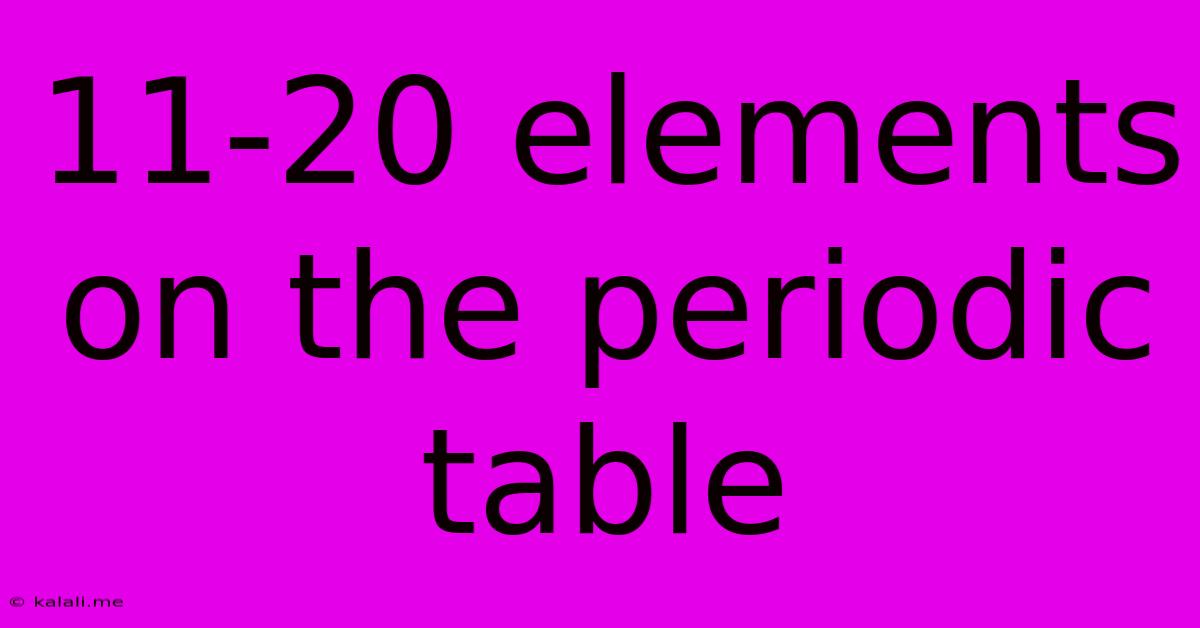11-20 Elements On The Periodic Table
Kalali
Jun 15, 2025 · 4 min read

Table of Contents
Exploring Elements 11-20 on the Periodic Table: A Deep Dive into the Building Blocks of Matter
This article delves into the fascinating properties and applications of elements 11 through 20 on the periodic table, moving beyond the basics to explore their unique characteristics and significance in various fields. Understanding these elements is crucial for anyone studying chemistry, materials science, or related disciplines. We'll examine their atomic structure, chemical reactivity, and practical uses, revealing the intricate story behind these fundamental building blocks of the universe.
Sodium (Na) - Element 11: The Energetic Alkali Metal
Sodium, an alkali metal, is incredibly reactive and readily loses its single valence electron. This explains its low ionization energy and high electropositivity. Its abundance and reactivity make it vital in various applications:
- Sodium Chloride (NaCl) – Table Salt: A crucial component of our diet and a fundamental chemical compound.
- Sodium Hydroxide (NaOH) – Lye: Used extensively in soap making, paper production, and various industrial processes.
- Sodium Lamps: Produce a distinctive yellow light, commonly used in streetlights and other outdoor lighting.
Its reactivity necessitates careful handling, particularly when exposed to water. Understanding its properties is essential for safe and effective utilization.
Magnesium (Mg) - Element 12: The Lightweight Champion
Magnesium is a lightweight, strong, and reactive alkaline earth metal with numerous industrial applications. Its key properties include:
- Lightweight and Strong: Widely used in aircraft construction and automotive components.
- Excellent Electrical Conductivity: Used in electronics and as a sacrificial anode to prevent corrosion.
- Essential Nutrient: Plays a crucial role in human and plant biology.
Aluminum (Al) - Element 13: The Versatile Metal
Aluminum, a post-transition metal, is the most abundant metal in the Earth's crust. Its remarkable properties have made it indispensable:
- Lightweight and Corrosion-Resistant: Ideal for packaging (cans, foil), construction, and transportation.
- High Electrical Conductivity: Used in power lines and electrical components.
- Recyclable: An environmentally friendly material, easily recycled with minimal energy loss.
Silicon (Si) - Element 14: The Semiconductor Star
Silicon, a metalloid, holds a pivotal position in modern technology. Its unique properties underpin the semiconductor industry:
- Semiconductor Properties: Forms the foundation of microchips, transistors, and solar cells.
- Abundant in the Earth's Crust: Makes it a cost-effective material for large-scale production.
- Silicones: Used in a vast array of applications, from lubricants to cosmetics.
Phosphorus (P) - Element 15: The Essential Nonmetal
Phosphorus, a nonmetal, exists in several allotropes, each with distinct properties. Its significance lies in:
- Essential Nutrient: Crucial for plant growth and plays a critical role in biological processes.
- Fertilizers: A key component of fertilizers, boosting agricultural productivity.
- Matches and Fireworks: Used in the production of matches and fireworks due to its flammability.
Sulfur (S) - Element 16: The Reactive Nonmetal
Sulfur, a nonmetal, is a reactive element with many important applications:
- Sulfuric Acid (H₂SO₄): A cornerstone chemical in industry, used in fertilizer production and various other processes.
- Vulcanization of Rubber: Improves the durability and elasticity of rubber.
- Medicinal Properties: Used in some medications and treatments.
Chlorine (Cl) - Element 17: The Disinfectant
Chlorine, a highly reactive halogen, is a potent disinfectant:
- Water Treatment: Used to disinfect water supplies, protecting public health.
- Bleach: A common household cleaning agent.
- Industrial Applications: Used in the production of various chemicals and plastics.
Argon (Ar) - Element 18: The Inert Noble Gas
Argon, a noble gas, is unreactive and finds applications where inert atmospheres are needed:
- Welding: Used as a shielding gas in welding to prevent oxidation.
- Light Bulbs: Prevents the filament from oxidizing and extending its lifespan.
- Scientific Instrumentation: Used in various scientific instruments and analytical techniques.
Potassium (K) - Element 19: The Essential Electrolyte
Potassium, an alkali metal, is vital for biological functions:
- Electrolyte Balance: Essential for maintaining proper electrolyte balance in the body.
- Plant Nutrition: An important nutrient for plant growth and development.
- Industrial Applications: Used in the production of various chemicals and fertilizers.
Calcium (Ca) - Element 20: The Structural Element
Calcium, an alkaline earth metal, is crucial for biological structures and functions:
- Bones and Teeth: A major component of bones and teeth, providing structural support.
- Muscle Contraction: Plays a role in muscle contraction and nerve impulse transmission.
- Cement and Plaster: Used in the construction industry as a key component of cement and plaster.
This exploration of elements 11-20 highlights their diverse properties and widespread applications. From the essential nutrients supporting life to the technological marvels shaping modern society, these elements underscore the intricate interconnectedness of the natural world and human ingenuity. Further research into these elements reveals even greater depth and complexity, continuing to inspire scientific advancement and innovation.
Latest Posts
Latest Posts
-
A Piece Of Land Surrounded By Water On Three Sides
Jun 15, 2025
-
Least Common Multiple Of 3 4 And 7
Jun 15, 2025
-
Which Of The Following Is A Metaphor
Jun 15, 2025
-
What Is A Central Idea In This Passage
Jun 15, 2025
-
What Day Of The Week Is November 17
Jun 15, 2025
Related Post
Thank you for visiting our website which covers about 11-20 Elements On The Periodic Table . We hope the information provided has been useful to you. Feel free to contact us if you have any questions or need further assistance. See you next time and don't miss to bookmark.